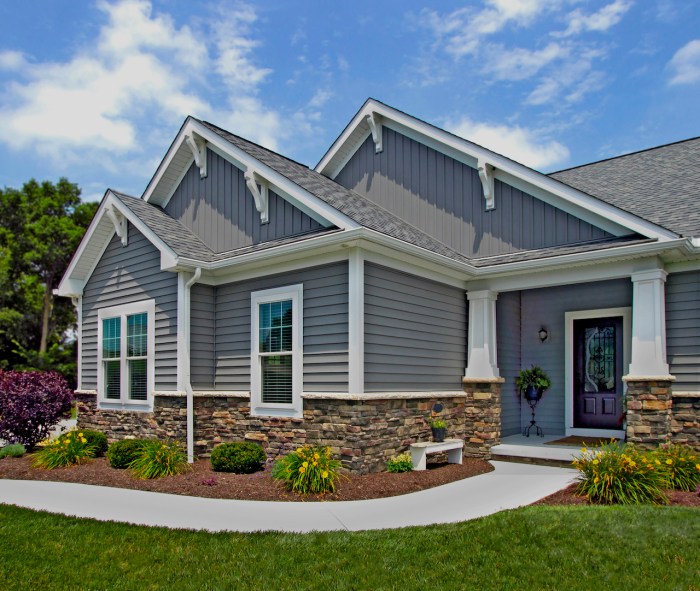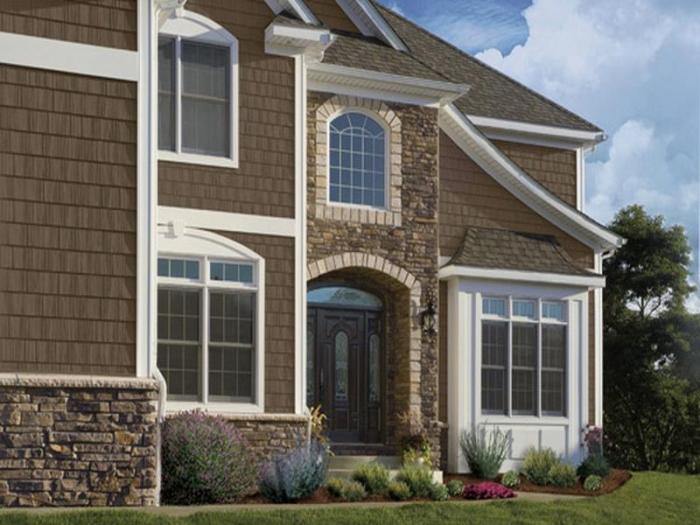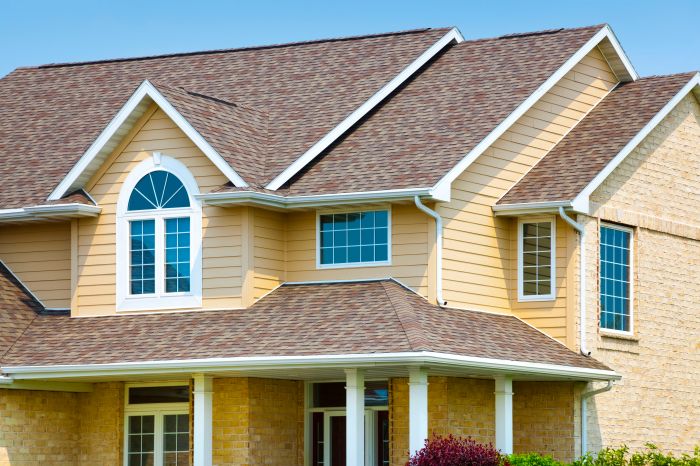Exploring New Home Siding Options: A Comprehensive Guide
Embark on a journey through the world of new home siding options, where we unravel the different materials, trends, and technologies shaping the industry. This introduction sets the stage for an insightful exploration that will leave you well-informed and inspired.
In the following paragraphs, we will delve into various aspects of siding options, from traditional materials to sustainable choices and innovative technologies.
Types of New Home Siding Options

When it comes to choosing the right siding for your home, there are various options available in the market. Each type of siding material has its own set of pros and cons in terms of durability, maintenance, cost, and aesthetics.
It's essential to weigh these factors before making a decision.
1. Vinyl Siding
Vinyl siding is a popular choice due to its affordability and low maintenance. It comes in a variety of colors and styles, making it versatile for different home designs. However, it may not be as durable as other materials and can crack or fade over time.
2. Wood Siding
Wood siding provides a timeless, natural look to a home and can be painted or stained in various colors. It is durable and has excellent insulation properties. On the downside, wood siding requires regular maintenance, such as painting or sealing, to prevent rot or pest damage.
3. Fiber Cement Siding
Fiber cement siding is a durable and low-maintenance option that can mimic the look of wood or masonry. It is resistant to fire, insects, and rot, making it a long-lasting choice. However, installation costs can be higher compared to other materials.
4. Metal Siding
Metal siding, such as steel or aluminum, is known for its durability and weather resistance. It is a sustainable option that is recyclable and energy-efficient. However, metal siding may dent easily and require repainting over time.
5. Engineered Wood Siding
Engineered wood siding is a blend of wood fibers and resin, providing the look of real wood with added durability and moisture resistance. It is available in various textures and finishes, offering a customizable aesthetic. However, it may be more expensive than traditional wood siding.
Sustainable and Eco-Friendly Siding Choices
When it comes to choosing siding materials for your home, opting for sustainable and eco-friendly options can have a positive impact on the environment. These materials not only help reduce the carbon footprint of your home but also contribute to energy efficiency.
Bamboo Siding
Bamboo is a highly sustainable material that grows rapidly and is considered a renewable resource. Bamboo siding is not only eco-friendly but also durable and resistant to moisture, making it a great choice for siding options.
Recycled Wood Composite Siding
Using recycled wood fibers and other environmentally friendly materials, recycled wood composite siding offers a sustainable alternative to traditional wood siding. This option helps reduce deforestation and waste while providing a similar aesthetic to natural wood siding.
Fiber Cement Siding
Fiber cement siding is a durable and low-maintenance option made from a mixture of wood fibers, cement, and sand. This material is fire-resistant, rot-proof, and termite-proof, making it a long-lasting and environmentally friendly choice for home siding.
Certifications and Standards
When choosing eco-friendly siding options, homeowners should look for certifications such as Forest Stewardship Council (FSC) certification for sustainably sourced wood or Cradle to Cradle certification for materials that can be recycled or composted. These certifications ensure that the siding materials meet specific environmental standards and criteria.
Popular Color and Texture Trends

When it comes to choosing the right siding for your home, color and texture play a significant role in the overall aesthetic appeal. Let's explore some of the popular color and texture trends that are making waves in the market.
Gray Tones
Gray tones have become increasingly popular in modern home siding choices. From light gray to charcoal, these hues offer a sleek and contemporary look to any home. The versatility of gray allows for easy pairing with other colors and materials, making it a top choice for many homeowners.
Wood Grain Textures
While traditional wood siding requires maintenance, modern siding options now offer wood grain textures that mimic the look of real wood without the upkeep. These textures add depth and warmth to the exterior of a home, creating a natural and inviting feel.
Dark Blues and Greens
Bold and rich colors like dark blues and greens are gaining popularity in siding choices. These deep hues make a statement and add a touch of sophistication to a home's exterior. Paired with white trims or accents, dark blues and greens create a striking contrast that catches the eye.
Textured Finishes
Textured finishes, such as stucco or brick patterns, are also trending in the siding market. These finishes add visual interest and dimension to a home's facade, creating a dynamic and unique look. Whether you prefer a rough or smooth texture, there are plenty of options to choose from to elevate your home's curb appeal.
Innovative Siding Technologies
In the ever-evolving world of home construction, innovative siding technologies are revolutionizing the way we think about siding options for houses. These cutting-edge solutions are not only enhancing the aesthetics of homes but also providing practical benefits that cater to the needs of modern homeowners.
Smart Siding Solutions
Smart siding solutions are one of the most prominent advancements in the siding industry. These technologies incorporate features like built-in insulation, moisture resistance, and enhanced durability. By integrating these elements into the siding material itself, homeowners can enjoy increased energy efficiency, reduced maintenance requirements, and longer-lasting curb appeal for their homes.
- Integrated Insulation: Smart siding options often come with built-in insulation that helps regulate indoor temperatures, leading to lower energy bills and increased comfort for residents.
- Moisture Resistance: Innovative siding technologies offer superior moisture resistance, protecting homes from water damage and mold growth, especially in humid climates.
- Durability: With advancements in material science, smart siding solutions are more durable than ever, capable of withstanding harsh weather conditions and maintaining their appearance for years to come.
Technological Advancements in the Siding Industry
The rapid pace of technological advancements is reshaping the siding industry by introducing new materials and manufacturing processes. These advancements are not only improving the performance of siding products but also expanding design possibilities for homeowners looking to customize their exteriors.
Innovations like 3D printing and composite materials are pushing the boundaries of what is possible in siding design, allowing for intricate patterns, textures, and colors that were previously unattainable.
- 3D Printing: Siding manufacturers are increasingly utilizing 3D printing technology to create unique and customizable siding panels that can mimic the look of traditional materials like wood or stone.
- Composite Materials: Composite siding options are gaining popularity due to their durability, low maintenance requirements, and eco-friendly properties. These materials combine natural fibers with recycled plastics to create a sustainable and long-lasting siding solution.
Final Summary

Wrapping up our discussion on new home siding options, we have covered a wide range of topics from materials to trends. The world of siding is evolving, offering homeowners exciting choices to enhance the aesthetics and functionality of their homes.
FAQ Overview
What are the most common types of siding materials used for homes?
Common siding materials include vinyl, wood, fiber cement, metal, and brick.
How do eco-friendly siding options contribute to energy efficiency?
Eco-friendly siding materials are often better insulators, reducing the need for excessive heating or cooling, thus increasing energy efficiency.
Are there any specific certifications homeowners should look for when choosing eco-friendly siding?
Look for certifications like Energy Star or LEED to ensure the sustainability and eco-friendliness of the siding materials.
What are some popular color and texture trends in home siding?
Currently, neutral tones like grays and blues are popular, along with textured finishes that mimic natural materials like wood.
How do innovative siding technologies improve home maintenance?
Innovative technologies such as smart siding can offer features like self-cleaning surfaces or integrated insulation, making maintenance easier and more efficient.